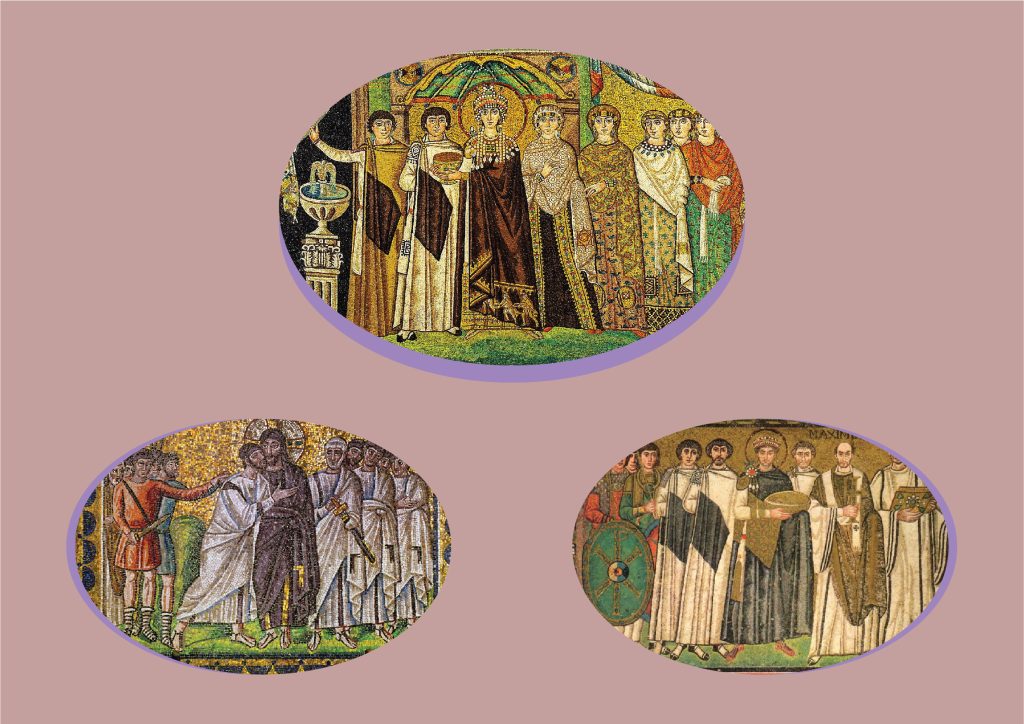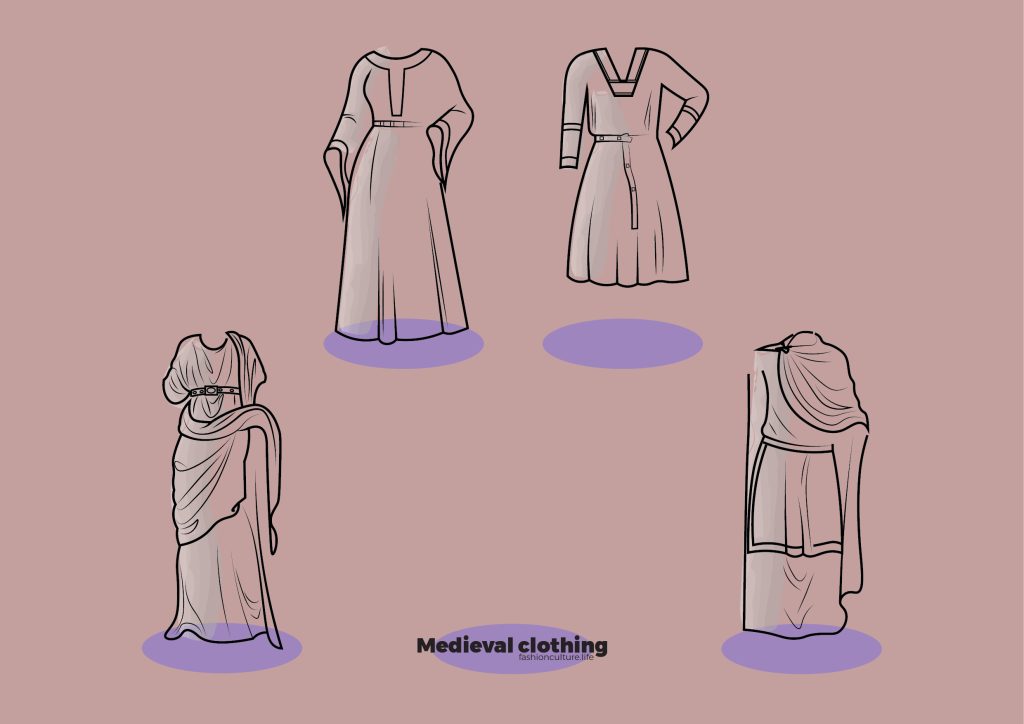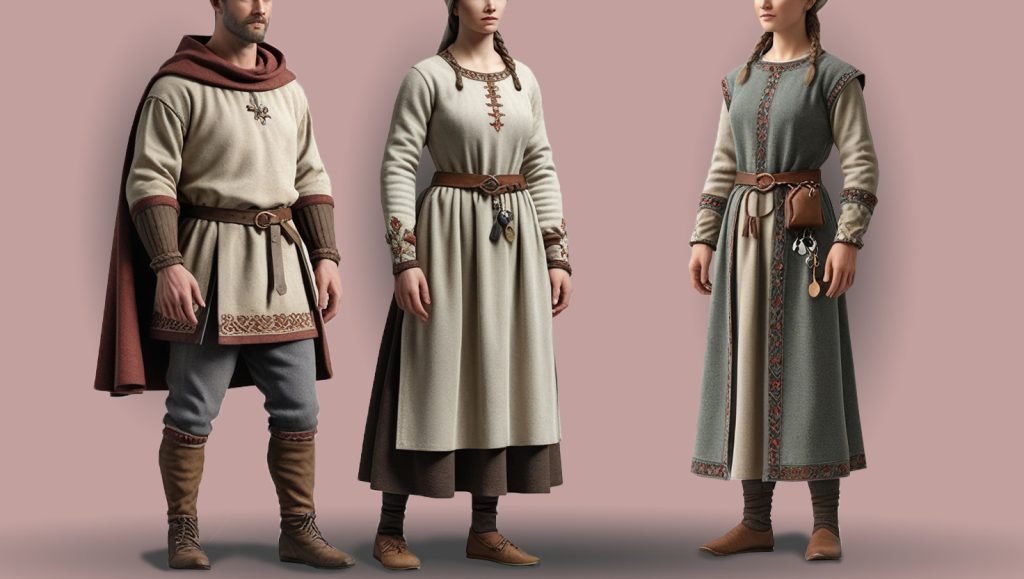Early Medieval Fashion, or Dark Ages clothing, was an incarnation of the dynamic cultural changes the period was to face. The remains of Roman influence mingled with the Germanic and Celtic, together with other tribal traditions, as medieval attire developed to respond to the needs of this changing society. Practicality and durability were the main issues while developing clothes to meet medieval hard conditions. While it also served to identify social rank, clothing bore deep cultural and religious meaning. It was in this period that the very foundations of medieval European fashion were laid down, on which styles continued to develop through successive centuries.
Materials and Fabrics
During the Early Medieval period 500-1000 CE-most of the attire was made of natural fibers, but wool and linen were mostly used. Their availability and quality depended on regional climate, social status, and established trade connections.
Cloth making was largely a cottage industry; women span and wove woolen cloth. Woolen fabric was done on an upright loom, the quality of cloth depending on one’s status: “high-class” had sophisticated weaves like in herringbone and diamond shapes as against simple, useful weaves to stand wear and tear that characterized everyday fabrics.
Primary Textiles
- Wool: The most common fabric used was wool, acquired from locally reared sheep. The quality varied due to the peculiarities of the climate. The northern sheep had coarser and thicker wool-perfect for warm and lasting clothes-while in the south, the wool was finer and more suitable for soft, much more comfortable clothes. Wool came to be among the preferred fabrics among people both humble and nobility, because it allowed versatility and insulation.
- Linen: Linen, which is produced from the flax plant, was extremely labor-intensive to produce but was highly valued for its lightness and breathability. For this reason, it was mainly used for undergarments, tunics, and summer clothes that kept the wearer cool. The nobles had finer, more delicate linens, while coarser weaves were used by the lower classes.
- Silk: Silk was a rare and luxurious material imported from the Byzantine Empire and Islamic Caliphates. Its softness and brilliant sheen made it accessible to kings, high-ranking clergy, and nobility only. It was highly inaccessible and at a great price, therefore very well reflecting their symbolic power and prestige. Gold and silver threads on fine wool or linen were also used for embroideries to provide the richness effect of silk fabrics when people couldn’t afford the real fabric.
Dye Sources and Techniques
Natural dyes opened up a whole realm of diverse colors and patterns where some shades were determined by economics and therefore associated with status or class; dyes revealed sharp contrasts between different regions: techniques varied depending on the circumstances within the province itself, again varying according to availability.
- Blue: Of the common and more enduring early medieval dyes, blue was extracted from woad. More widely used by the upper classes, yet less accessible than it would be in later periods when indigo and other methods became more common.
- Red:Red, derived from madder root, was considered a very noble color, connoting nobility, power, and the military. Until the medieval ages, its application was limited owing to the use of complicated technologies in dyeing, which is far more modern than those previously used.
- Yellow: Of weld, yellow was a relatively accessible dye, although its intensity and richness varied depending on the dyeing technique. Less saturated than the brilliant yellows of later periods, this color was far more common in everyday wear, but still limited in range.
Those plant-based dyes existed, but they were not used to the degree they would have seen in the succeeding medieval period. Brighter and more extreme colours tended to belong to those from a wealthier class; these more everyday and sombre hues would therefore prove to be rather ordinary colors commoners might sport. This way of dyeing practiced in Early Medieval gave further development toward much higher, greater diversification within High Medieval and Renaissance.
Clothing for Men
- Tunic :
The tunic was the commoner’s basic garment, worn through the social scale. A very simple garment of construction, a basically T-shaped piece of wool or linen varied in length to the knee for everyday wear to full ankle for ceremonial occasions; embroidered borders and colorful trims or patterns carried status messages and regional affiliations on the tunics of the better off. They are long sleeved, sometimes narrow and other times wide; these tunics were secured with a leather or fabric belt around the waist. - Breeches and Leggings:
These were loose-fitting trousers worn under the tunic, usually tied at the waist with cord or belt. Because they were of wool for warmth, they reached to the ankles and granted flexibility in moving the legs. Leggings involved separate strips of fabric or very long pieces of cloth tightly wrapped around the lower legs and then secured with leather thongs or strings. - Cloak:
Cloaks were the main outerwear garment in men’s wear for protection against inclement weather. Made of thick and water-resistant wool, often knee or ankle length, cloaks were clasped at the shoulder with metal brooches or decorated clasps for ease of mobility. The lining of cloaks with fur for additional warmth and as a touch of luxury was afforded by the rich, while commoners used simpler types with restricted embellishment. - Dalmatica :
a long, loose robe reaching to the ankles, distinguished by its wide sleeves. It was worn by nobles and the clergy; it was usually made from luxurious fabrics like silk or fine wool. On it, embellishments such as gold threads, embroidery, or even gemstones were added, showing the status of the wearer. The dalmatica was therefore a very symbolic robe of privilege and reserved for formal occasions. - Chiton :
Inspired by Mediterranean traditions, the chiton was a long, loose robe reaching to the ankles, distinguished by its wide sleeves. It was worn by nobles and the clergy; it was usually made from luxurious fabrics like silk or fine wool. On it, embellishments such as gold threads, embroidery, or even gemstones were added, showing the status of the wearer. The dalmatica was therefore a very symbolic robe of privilege and reserved for formal occasions.
Clothing for Women
- Chemise (Underdress):
A foundational garment for women, the chemise was a simple, ankle-length underdress made of linen. Worn directly against the skin, it absorbed perspiration and protected outer garments from wear. The usual design was loose-fitting with long sleeves and a modest neckline, reflecting its practical use and comfort. - Kirtle (Overdress):
The kirtle was worn as an overdress over the chemise. It could be sleeveless or with long, fitted sleeves and was usually of wool or linen. The kirtle reached down to the ankles and was secured at the waist by a belt, outlining the female form. The wealthier women often decorated their kirtles with embroidery or contrasting fabrics to indicate their status. - Mantle:
Mantles were large cloaks worn for warmth and modesty. They were made of such heavy wool, always fastened with an ornate brooch at the front and draped around the shoulders with elegance. This included fur trims or embroidered patterns for a noblewoman and simple, less elaborate types for peasants. - Tunica :
The tunic, which was worn by women, was basically similar to that worn by men but longer, reaching the ankles, and mostly worn in layers. It could have elaborate embroidering at the neckline, sleeves, and hem. The tunics of the rich women were made from finer material such as imported silk, while the poor people were made from wool or linen.
Children’s Clothing
- Styles and Practicality: The dress for children was similar to the adults but much simpler and even heavier. In boys, tunics and loose breeches allowed ease of movement, while girls wore chemises over tunics, often fitted with belts that could be adjusted as the child grew.
- Materials: Wool was the primary material, while softer linens were kept for richer families. The strong fabric assured longevity since most garments were passed down or remade into another garment.
- Accessories: except perhaps a basic leather pouch, or a charm believed to provide protection from some harm. Shoes were basic in design and constructed from untreated leather.

Footwear and Accessories
-
Footwear:
- Caligae :
Originated as a Roman military boot, the caligae remained into the early medieval period. It was a heavy, open-toe leather boot with thick soles nailed on with iron nails, hence suitable for soldiers and travelers; less elegant, so nobility did not normally wear them. - Soccus :
A soft, shoe-slipper-like footwear in leather or cloth, which was perfect for indoor work and outdoor walking. Socci had simple designs with little decoration and therefore were accessible even to ordinary people. - Calcei :
The calcei were a type of closed leather shoe with a round toe, basically designed for cold or wet conditions. They generally included extra padding or fur lining for added warmth and lacing or straps for fastening. Nobles favored dyed or embossed versions for added style.
- Caligae :
-
Belts and Bags:
Belts were practical items to secure tunic and to carry pouch or small knife. Pouches, being leather, often had intricate stitchings and/or metal clasps. A much wealthier person may add silver buckles to belts or perhaps gemstones.
-
Jewelry:
Accessories included brooches, pendants, arm rings, and necklaces. The wealthy preferred gold and silver set with precious stones, while bronze and iron were more common among the lower classes. Designs often featured religious symbols or tribal motifs, which denoted a person’s identity or beliefs.
Hairstyles and Grooming
- Hairstyles :
Hairstyles varied by social status and cultural influences:- Men’s Hairstyles:
Men often kept their hair short and neatly trimmed, reflecting practicality and hygiene. Among the nobility, carefully styled hair signaled refinement, while warriors and laborers might favor simpler looks for convenience. Beards and mustaches were also common, with some cultures associating facial hair with masculinity and power. - Women’s Hairstyles:
Women’s hairstyles were usually very elaborate, including braids, buns, and waves. Married women usually covered their hair as a sign of modesty, while girls, being unmarried, kept their hair open or decorated it with ribbons and other simple hair accessories. Hair was anointed with oil very often to keep it smooth and shiny.
- Men’s Hairstyles:
- Grooming :
Personal grooming was important, especially for the upper classes. The people used bone or wooden combs to detangle their hair and applied natural oils for conditioning. Bathing was less frequent but made sure that cleanliness was there, adding scented herbs or oils to water for a nice aroma. -
Headwear :
- Cucullus :
A practical hood of thick wool, worn by travelers and peasants for warmth and protection against inclement weather. Its simplicity made it a staple among lower classes. - Pilleus :
A brimless cap of felt or wool, associated with the practical and untrammeled, worn by farmers and ordinary people. The design was more functional than decorative. - Wimple and Veil:
The wimple was a cloth put on the head and neck and symbolized modesty and piety. The garment was made from finely textured linen and might be plain or decorated with restrained embroidery; it was worn by married women. The veil was worn over or without the wimple and varied in shape, form, and length. A high-ranking lady might have used veils in sheer, airy materials to demonstrate her wealth, whereas more simplistic ones were staples of middle- and low-class attire.
- Cucullus :
Cultural and Religious Significance
Christian Influence:
As Christianity traversed Europe, the sense of modesty turned into the paramount theme in females’ clothes. The clergy then played a very important role in setting social expectations by encouraging modesty and condemning bold ornamentation or too-revealing apparel. This stress on modest dress was to become a reflection of spiritual purity and humility. Modest fashion is one trend that in recent times has steadily gained popularity, especially in cultures that are so inclined either by religious or cultural values. Most designers of modest fashion today draw inspiration from medieval Christianity, where simplicity and respect for the body are things to be considered.
Symbolism in Colors and Patterns:
Much of the symbolism in Early Medieval garb was seen through colors and patterns, with meanings associated with them. The color blue was most strongly associated with the Virgin Mary, purity, and devotion. Red, on the other hand, generally came to be used to denote some sort of power, authority, or martyrdom. The color associations were not only religious but also acted as social markers that denoted one’s place or role within society. In modern fashion, historical uses of color are still applied. Designers often use color to express emotions, power, or social status by borrowing from medieval symbolism. Also, tribal and regional patterns reflective of one’s heritage or position in society still have a modern expression in fashions embracing ethnic and cultural identity.
Legacy and Influence
Inspiration for Modern Fashion:
The idea of layering, natural fibers such as wool and linen, and fundamentally practical designs that characterized fashion during the Early Medieval period have inspired the growing interest in sustainable fashion in recent years. Many contemporary designers revisit these forms of medieval attire, including cloaks, tunics, and complex embroidery techniques, in their desire to merge practicality with art. Fashion seems to take a cue from certain medieval styles of clothing in such fantasy genres as The Lord of the Rings and Game of Thrones. These cinematic adaptations show that medieval fashion, in its level of detailed craftsmanship and use of symbolism, is appealing to modern audiences.
Cultural Preservation and Modern Relevance:
Medieval re-enactments, museum exhibitions and historic fashion shows keep Early Medieval traditions alive, respectful not only of the skill and artistic taste of the past but also in allowing modern-day audiences to reach out and literally touch history, in which society today keeps modern civilization in by wearing and finding out about what each piece would mean to someone culturally. Such an act of preservation preserves the style and values of the Early Medieval period for successive generations, influencing and inspiring them. Today, the fashion industry keeps itself attached to the past through enactments of history or postmodern reinterpretations, proving that its evolution is one big, continuous process influenced by the centuries of tradition.


